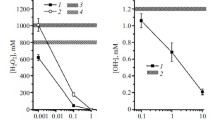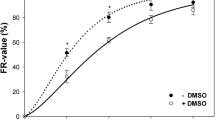Abstract
We have examinedin vitro andin vivo radioprotective effects of a well-known thiol-containing compound, dithiothreitol (DTT). The treatment of both 0.5 and 1 mM of DTT significantly increased clonogenic survival of γ-ray irradiated Chinese hamster (V79-4) cells. In order to investigate the possible radioprotective mechanism of DTT, we measured γ-ray induced chromosome aberration by micronucleus assay. In the presence of 0.5 mM or 1 mM DTT, the frequencies of micronuclei were greatly reduced in all dose range examined (1.5–8 Gy). Slightly higher reduction in micronucleus formation was observed in 1 mM DTT-treated cells than in 0.5 mM DTT-treated cells. In addition, incubation with both 0.5 and 1 mM of DTT prior to γ-ray irradiation reduced nucleosomal DNA fragmentation at about same extent, this result suggests that treatment of DTT at concentrations of 0.5 and 1 mM reduced radiation-induced apoptosis.In vivo experiments, we also observed that DTT treatment reduced the incidence of apoptotic cells in mouse small intestine crypts. In irradiated control group 4.4±0.5 apoptotic cells per crypt were observed. In DTT-administered and irradiated mice, only 2.1±0.4 apoptotic cells per crypt was observed.In vitro andin vivo data obtained in this study showed that DTT reduced radiation-induced damages and it seems that the possible radioprotective mechanisms of action of DTT are prevention of chromosome aberration.
Similar content being viewed by others
References Cited
Almássy, Z., Krepinsky, A. B., Bianco, A. and Kteles, G. J., The present state and perspectives of micronucleus assay in radiation protection. A review.Appl. Radiat. Isot., 38, 241–249 (1987).
Berk, L. B., Patrene, K. D. and Boggs, S. S., 16,16-dimethyl prostaglandin E2 and/or syngeneic bone marrow transplantation increase mouse survival after supra-lethal total body irradiation.Int. J. Radiat. Oncol. Biol. Phys., 18, 1387–1392 (1990).
Bump, E. A. and Brown, J. M., Role of glutathione in the radiation response of mammalian cellsin vitro andin vivo.Pharmacol. Ther., 47, 117–136 (1990).
Bump, E. A., Cerce, B. A., Al-Sarraf, R., Pierce, S. M. and Koch, C. J., radioprotection of DNA in isolated nuclei by naturally occurring thiols at intermediate oxygen tension.Radiat. Res., 132, 94–104 (1992).
Grdina, D. J. and Nagy, B., The effect of 2-[(aminopropyl)aminol] ethanethiol (WR-1065) on radiation-induced DNA damage and reapair and cell progression.British J. Cancer, 54, 933–941 (1986).
Grdina, D. J., Nagy, B., Hill, C. K., Wells, R. L. and Peraino, C., The radioprotector WR-1065 reduces radiation-induced mutations at the hypoxanthine-guanine phosphorybosyl transferase locus in V79 cells.Carcinogenesis, 6, 929–931 (1985).
Hanson, W. R., Radiation protection of murine intestine by WR-2721, 16,16-dimethyl prostaglandin E2, and the combination of both agents.Radiat. Res., 111, 361–373 (1987).
Held, K. D. and Melder, D. C., Toxicity of the sulfhydryl-containing radioprotector dithiothreitol.Radiat. Res. 112, 544–554 (1987).
Hyun, S. J., Yoon, M. Y., Kim, T. H. and Kim, J. H., Enhancement of mitogen-stimulated proliferation of low dose radiation-adapted mouse splenocytes.Anticancer Res., 17, 225–230 (1997).
Issels, R. D., Biaglow, J. E., Epstein, L. and Gerweck, L. E., Enhancement of cysteamine cytotoxicity by hyperthermia and its modification by catalase and superoxide dismutase in Chinese hamster ovary cells.Cancer Res., 44, 3911–3915 (1984).
Kim, J. H., Lee, K. J., Cho, C. K., Yoo S. Y., Kim, T. H., Ji, Y. H. and Kim, S. H., Adaptive response induced by low dose ionizing radiation in human cervical carcinoma cells.Arch. Pharm. Res., 18, 410–414 (1995a).
Kim, J. H., Lee, K. J., Cho, C. K., Yoo, S. Y., Kim, T. H. and Kim, S. H., Adaptive response induced by low dose ionizing radiation in human lymphocytes.J. Korean. Asso. Radiat. Prot., 20, 97–102 (1995b).
Kim, J. H., Hahm, K. H., Cho, C. K. and Yoo, S. Y., Protein biosynthesis in low dose ionizing radiation-adapted human melanoma cells.J. Radiat. Res., 37, 161–169 (1996).
Kim, J. H., Hyun, S. J., Yoon, M. Y., Ji, Y. H., Cho, C. K. and Yoo, S. Y., Pretreatment of low dose radiation reduces radiation-induced apoptosis in mouse lymphoma (EL4) cells.Arch. Pharm. Res. 20, 212–217 (1997).
Kim, J. H., Kim, S. H., Lee, E. J., Gao, J., Wu, Z., Mar, W. and Chang, I. M., Radioprotective effect of Lifukang, a Chinese medicinal plants prescription.Natural Prod. Sci., 4, 26–31 (1998).
Kim, S. G., Nam, S. Y., Kim, C. W., Kim, J. H., Cho, C. K. and Yoo, S. Y., Enhancement of radiation-inducible hepatic glutathione-S-transferaseYa, Yb1, Yb2, Yc1, andYc2 gene expression by oltipraz: Possible role in radioprotection.Mol. Pharm., 51, 225–233 (1997).
Livesey, J. C. and Reed, D. J., Chemical protection against ionizing radiation.Adv. Radiat. Biol., 13, 285–353 (1987).
Mori, T., Watanabe, M., Horikawa, M., Nakaido, P., Kimura, H., Aoyama, T. and Sugahara, T., WR-2721, its derivatives and their radioprotective effects on mammalian cells in culture.Int. J. Radiat. Biol., 44, 41–53 (1983).
Nam, S. Y., Kim, J. H., Cho, C. K., Yoo, S. Y. and Kim, S. K., Enhancement of radiation-induced hepatic microsomal epoxide hydrolase gene by oltipraz in rats.Radiat. Res., 147, 613–620 (1997).
Patt, H. W., Tyree, E. B., Straube, R. L. and Smith, D. E., Cysteine protection against X irradiation.Science, 110, 213–214 (1949).
Radford, I. R., Murphy, T. K., Radley, J. H. and Ellis, S. L., Radiation response of miuse lymphoid and myeloid cell lines. Part II. Apoptotic cell death is shown by all cell lines examined.Int. J. Radiat. Biol., 65, 217–227 (1994).
Rèvèsz, L., The role of endogeneous thiols in intrinsic radioprotection.Int. J. Radiat. Biol., 47, 361–368 (1985).
Smoluk, G. D., Fahey, R. C., Calabro-Jones, P. M., Aguilera, J. A. and Ward, J. F., Radioprotection of cells in culture by WR2721 and derivatives: Form of the drug responsible for protection.Cancer Res., 48, 3641–3647 (1988).
Sölen, G., Edgren, M., Scott, O. C. A. and Révész, L., Radiosensitization by oxygen and radioprotection by thiols: analysis of the combined action according to a modified competition model.Int. J. Radiat. Biol., 57, 959–969 (1990).
Sölen, G., Edgren, M., Scott, O. C. A. and Révész, L., Radioprotection by dithiothreitol (DTT) at varying oxygen concentrations: prediction of a modified competition model and theory evaluation.Int. J. Radiat. Biol., 59:409–418.
van der Vijgh, W. J. F. and Peters, G., Protection of normal tissues from the cytotoxic effect of chemotheraphy and radiation by amifostine (Ethyol): Preclinical aspects.Seminars Oncol., 21, 2–7 (1994).
Wyllie, A. H., Glucocorticoid-induced thymocyte apoptosis is associated with endogenous endonuclease activation.Nature, 284, 555–556 (1980).
Author information
Authors and Affiliations
Rights and permissions
About this article
Cite this article
Kim, J.H., Lee, E.J., Hyun, J.W. et al. Reduction of radiation-induced chromosome aberration and apoptosis by dithiothreitol. Arch. Pharm. Res. 21, 683–687 (1998). https://doi.org/10.1007/BF02976757
Received:
Issue Date:
DOI: https://doi.org/10.1007/BF02976757




